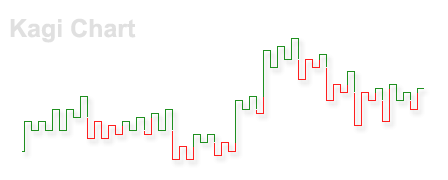Kagi chart on:
[Wikipedia]
[Google]
[Amazon]
 The Kagi chart () is a chart used for tracking price movements and to make decisions on purchasing
The Kagi chart () is a chart used for tracking price movements and to make decisions on purchasing
A Look At Kagi Charts, Investopedia
Retrieved 16 Oct 2008. A Kagi chart is created with a series of vertical lines connected by short horizontal lines. The thickness and direction of the lines is based on the price of the underlying stock or asset, as follows: * The thickness/color of the line changes when the price reaches the high or low of the previous vertical line. * The direction of the line changes when the price reaches a preset reversal amount, which is usually set at 4%. When a direction change occurs, a short horizontal line is drawn between the lines of opposite direction. Alternatively, thin and thick lines can be replaced with lines of different colours. Changes in line thickness are used to generate transaction signals. Buy signals are generated when the Kagi line goes from thin to thick and sell signals are generated when the line turns from thick to thin. The basic
 The Kagi chart () is a chart used for tracking price movements and to make decisions on purchasing
The Kagi chart () is a chart used for tracking price movements and to make decisions on purchasing stock
In finance, stock (also capital stock) consists of all the shares by which ownership of a corporation or company is divided.Longman Business English Dictionary: "stock - ''especially AmE'' one of the shares into which ownership of a company ...
. It differs from traditional stock charts such as the Candlestick chart
A candlestick chart (also called Japanese candlestick chart or K-line) is a style of financial chart used to describe price movements of a security, derivative, or currency.
It is similar to a bar chart in that each candlestick represents all f ...
by being mostly independent of time. This feature aids in producing a chart that reduces random noise
In electronics, noise is an unwanted disturbance in an electrical signal.
Noise generated by electronic devices varies greatly as it is produced by several different effects.
In particular, noise is inherent in physics, and central to the ...
.
Due to its effectiveness in showing a clear path of price movements, the Kagi chart is one of the various charts that investors use to make better decisions about stocks. The most important benefit of this chart is that it is independent of time and change of direction occurs only when a specific amount is reached.
The Kagi chart was originally developed in Japan during the 1870s when the Japanese stock market started trading. It was used for tracking the price movement of rice
Rice is the seed of the grass species '' Oryza sativa'' (Asian rice) or less commonly '' Oryza glaberrima'' (African rice). The name wild rice is usually used for species of the genera '' Zizania'' and ''Porteresia'', both wild and domestica ...
and found use in determining the general levels of supply and demand for certain assets.
Construction
Kagi charts look similar to swing charts and do not have a time axis.Retrieved 16 Oct 2008. A Kagi chart is created with a series of vertical lines connected by short horizontal lines. The thickness and direction of the lines is based on the price of the underlying stock or asset, as follows: * The thickness/color of the line changes when the price reaches the high or low of the previous vertical line. * The direction of the line changes when the price reaches a preset reversal amount, which is usually set at 4%. When a direction change occurs, a short horizontal line is drawn between the lines of opposite direction. Alternatively, thin and thick lines can be replaced with lines of different colours. Changes in line thickness are used to generate transaction signals. Buy signals are generated when the Kagi line goes from thin to thick and sell signals are generated when the line turns from thick to thin. The basic
algorithm
In mathematics and computer science, an algorithm () is a finite sequence of rigorous instructions, typically used to solve a class of specific problems or to perform a computation. Algorithms are used as specifications for performing ...
used is:
# Find the starting point. The starting point is generally considered the first closing price. From this point forward, you compare each day's closing price with the starting price.
# Draw a thin vertical line from the starting price to each day's closing price, while the trend does not reverse.
# If a day's closing price moves in the opposite direction to the trend by more than the reversal amount, draw a short horizontal line and a new vertical line, beginning from the horizontal line to the new closing price.
# If the price on a day is greater than or equal to the previous high, change to a thick line and continue the vertical line. If the price on that day is less than or equal to the previous low, then change to a thin line.
References
Further reading
* Nison, Steve, ''Beyond Candlesticks: New Japanese Charting Techniques Revealed'', {{technical analysis Financial charts Japanese inventions